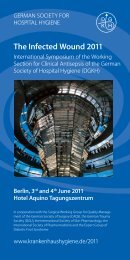Anforderungen an die Hygiene bei der Auf - Deutsche Gesellschaft ...
Anforderungen an die Hygiene bei der Auf - Deutsche Gesellschaft ...
Anforderungen an die Hygiene bei der Auf - Deutsche Gesellschaft ...
Erfolgreiche ePaper selbst erstellen
Machen Sie aus Ihren PDF Publikationen ein blätterbares Flipbook mit unserer einzigartigen Google optimierten e-Paper Software.
11<br />
Empfehlung <strong>der</strong> Kommission für Kr<strong>an</strong>kenhaushygiene und Infektionsprävention <strong>bei</strong>m Robert Koch-Institut (RKI)<br />
Recommendation of the Commission for Hospital <strong>Hygiene</strong> <strong>an</strong>d Infection Prevention at the Robert Koch Institute (RKI)<br />
• Bei m<strong>an</strong>ueller und teilautomatischer <strong>Auf</strong>bereitung ist<br />
das Datum des Ansetzens <strong>der</strong> Desinfektionsmittellösung<br />
z.B. auf <strong>der</strong> W<strong>an</strong>ne zu fixieren. Die Desinfektionsmittellösung<br />
ist nach Hersteller<strong>an</strong>gaben bzw.<br />
<strong>bei</strong> optischer Verschmutzung (Trübung) auch früher<br />
zu erneuern (Kategorie IB).<br />
• Bei m<strong>an</strong>ueller und teilautomatischer <strong>Auf</strong>bereitung<br />
sind alle zugänglichen K<strong>an</strong>äle des Endoskopes luftblasenfrei<br />
mit Desinfektionsmittellösung zu füllen<br />
(Kategorie IB).<br />
• Bei Wechsel <strong>der</strong> Desinfektionsmittellösung sind <strong>die</strong><br />
Desinfektionsw<strong>an</strong>nen gründlich mech<strong>an</strong>isch und<br />
desinfizierend zu reinigen (Kategorie IB).<br />
• W<strong>an</strong>nen zur Instrumentendesinfektion sollen abgedeckt<br />
sein (Luftbelastung, Umgebungskontamination)<br />
[40] (Kategorie IB).<br />
• Da im <strong>Auf</strong>bereitungsraum von einer erhöhten Belastung<br />
<strong>der</strong> Raumluft mit Desinfektionsmitteldämpfen<br />
auszugehen ist [97, 98], muss <strong>die</strong> Möglichkeit zur<br />
ausreichenden Lüftung o<strong>der</strong> eine separate Abzugsmöglichkeit<br />
aus Gründen des Ar<strong>bei</strong>tsschutzes gegeben<br />
sein [40, 45] (Kategorie IV).<br />
prepared must be retained, e.g. on the tray. The disinfect<strong>an</strong>t<br />
solution must, however, be renewed earlier<br />
as per the m<strong>an</strong>ufacturers‘ instructions <strong>an</strong>d/or in case<br />
of optical contamination (clouding) (Category IB).<br />
• In case of m<strong>an</strong>ual <strong>an</strong>d semi-automated reprocessing,<br />
all accessible ch<strong>an</strong>nels of the endoscope must<br />
be filled with a disinfect<strong>an</strong>t solution in such a way<br />
that no air bubbles are formed (Category IB).<br />
• Disinfection trays must be cle<strong>an</strong>ed mech<strong>an</strong>ically <strong>an</strong>d<br />
thoroughly in a disinfect<strong>an</strong>t m<strong>an</strong>ner when the disinfect<strong>an</strong>t<br />
solution is ch<strong>an</strong>ged (Category IB).<br />
• Trays for instrument disinfection shall be covered<br />
(atmospheric load, contamination to the environment)<br />
[40] (Category IB).<br />
• As it must be assumed that the reprocessing room‘s<br />
ambient air is more loaded with disinfect<strong>an</strong>t vapours<br />
[97, 98], sufficient ventilation or a separate extraction<br />
option must be provided for reasons of industrial<br />
safety [40, 45] (Category IV).<br />
3.4<br />
Schlussspülung zur Entfernung<br />
von Desinfektionsmittelrückständen<br />
3.4<br />
Final Rinsing for Removing<br />
Disinfect<strong>an</strong>t Residues<br />
Rückstände von Desinfektionsmittellösungen im Endoskop<br />
können chemische Irritationen und allergische<br />
Schleimhautreaktionen <strong>bei</strong>m nachfolgend untersuchten<br />
Patienten auslösen [99, 100, 101]. Zur Abspülung<br />
von Desinfektionsmittelrückständen ist jeweils frisches,<br />
mikrobiologisch einw<strong>an</strong>dfreies Wasser zu verwenden.<br />
Die Verwendung von Leitungswasser o<strong>der</strong> unsterilem<br />
Aqua dest. ist nicht ausreichend, da <strong>die</strong>se häufig mikrobiell<br />
(z. B. Pseudomonas spp., Legionella spp., atyp.<br />
Mykobakterien) kontaminiert sind. Hierdurch können<br />
Endoskop und K<strong>an</strong>alsystem nach sachgerechter Desinfektion<br />
rekontaminiert werden [68]. Bei m<strong>an</strong>gelhafter<br />
Trocknung k<strong>an</strong>n es während <strong>der</strong> Lagerung des Endoskopes<br />
zu einer Zunahme <strong>der</strong> Keimzahl kommen [102].<br />
• Die Desinfektionsmittellösung ist durch intensives<br />
Nachspülen <strong>der</strong> K<strong>an</strong>äle und des Außenm<strong>an</strong>tels des<br />
Endoskopes sorgfältig zu entfernen (Kategorie IB).<br />
• Zur Schlussspülung ist Wasser zu verwenden, das<br />
mikrobiologisch Trinkwasserqualität hat und frei von<br />
fakultativ pathogenen Mikroorg<strong>an</strong>ismen ist (Kategorie<br />
IB). Mikrobiologisch einw<strong>an</strong>dfreies Schlussspülwasser<br />
k<strong>an</strong>n durch Einsatz von Sterilwasserfiltern in ausreichen<strong>der</strong><br />
Menge bereitgestellt werden [92]. Die Leitlinie<br />
<strong>der</strong> „Association for Professionals in Infection Control<br />
<strong>an</strong>d Epidemiology“ (APIC-Guideline [45]) empfiehlt zur<br />
Schlussspülung <strong>die</strong> Verwendung von sterilem Wasser.<br />
• Bei <strong>der</strong> maschinellen <strong>Auf</strong>bereitung im RDG-E wird<br />
das Wasser zur Schlussspülung – je nach Gerätemodell<br />
– durch Erhitzen desinfiziert, sterilfiltriert o<strong>der</strong><br />
durch UV-Bestrahlung desinfiziert. Die maschinelle<br />
<strong>Auf</strong>bereitung ist daher bezüglich <strong>der</strong> mikrobiologischen<br />
Qualität des zur Schlussspülung verwendeten<br />
Wassers sicherer und auch deshalb <strong>der</strong> m<strong>an</strong>uellen<br />
Residues of disinfect<strong>an</strong>t solutions in the endoscope<br />
c<strong>an</strong> trigger chemical irritations <strong>an</strong>d allergic reactions of<br />
the mucous membr<strong>an</strong>e in the subsequently examined<br />
patient [99, 100, 101]. Fresh, microbiologically impeccable<br />
water must be used for rinsing off disinfect<strong>an</strong>t<br />
residues. Using tap water or unsterile distilled water is<br />
not sufficient as they are often microbially contaminated<br />
(e.g. Pseudomonas spp., Legionella spp., atyp. mycobacteria).<br />
Endoscopes <strong>an</strong>d ch<strong>an</strong>nel systems could thus<br />
be recontaminated after proper disinfection [68]. Bacterial<br />
count c<strong>an</strong> increase during storage of the endoscope<br />
after insufficient drying [102].<br />
• The disinfect<strong>an</strong>t solution must be removed meticulously<br />
by intensively re-rinsing ch<strong>an</strong>nels <strong>an</strong>d the<br />
outer casing of the endoscope (Category IB).<br />
• For final rinsing, water which is microbiologically<br />
potable <strong>an</strong>d free from facultative pathogenic microorg<strong>an</strong>isms<br />
must be used (Category IB). Microbiologically<br />
impeccable final rinse water c<strong>an</strong> be provided in<br />
a sufficient qu<strong>an</strong>tity by using sterile water filters [92].<br />
The guideline of the ”Association for Professionals in<br />
Infection Control <strong>an</strong>d Epidemiology“ (APIC-Guideline<br />
[45]) recommends the use of sterile water for final<br />
rinsing.<br />
• In case of automated reprocessing in EWDs, the<br />
water for final rinsing is disinfected by heating, un<strong>der</strong>goes<br />
sterile filtration or is disinfected by UV radiation<br />
– depending on the device type. Automated<br />
reprocessing is thus safer in terms of microbiological<br />
quality of water used for final rinsing. This is one of<br />
the reasons why it should be given preference over<br />
m<strong>an</strong>ual <strong>an</strong>d semi-automated reprocessing [68].<br />
Automated reprocessing in appli<strong>an</strong>ces which dis-<br />
Erstmalig veröffentlicht in Bundesgesundheitsbl Gesundheitsforsch – Gesundheitsschutz | first published in Fe<strong>der</strong>al Health Gazette Health Research – Health Protection<br />
2002 • 45:395–411 © Springer-Verlag 2002



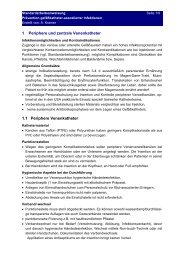
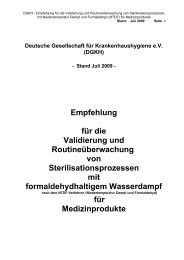


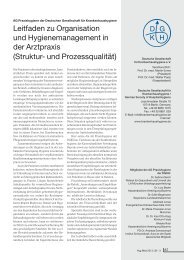

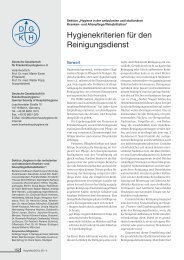


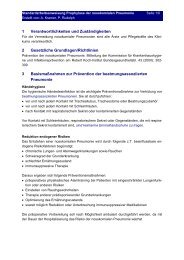

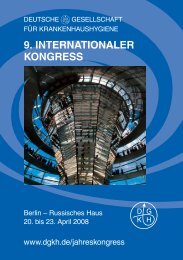
![Hauptprogramm [A4-Quer] - Deutsche Gesellschaft für ...](https://img.yumpu.com/6449478/1/184x260/hauptprogramm-a4-quer-deutsche-gesellschaft-fur-.jpg?quality=85)
